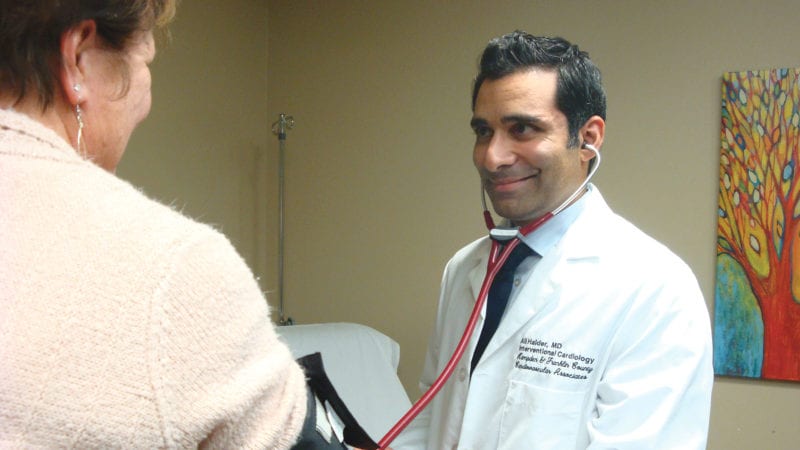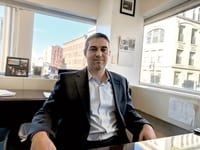Heart of the Matter -Knowledge is Key to Treating, Preventing Heart Attacks
Dr. Amir Lotfi says it not unusual for someone who suffers a heart attack to say they had no idea it was happening.
Indeed, this is a common reaction, said Lotfi, associate chief of Cardiology for Baystate Health, adding that many people generally believe that a heart attack presents itself as immense pain — the proverbial ‘elephant sitting on the left side of my chest’ line you hear so often.
But while that certainly happens for some, heart attack symptoms can also emerge in other areas of the body, such as the shoulder or jaw, and they don’t always exhibit excruciating pain.
“When I ask patients if they are having pain, they often describe it more as feeling pressure or tightness,” said Lotfi, adding that this reality is just one of many that make it challenging to treat and prevent heart attacks.
Dr. Ali Haider, an interventional cardiologist with Cooley Dickinson Hospital, agreed. He said many people mistake heart-attack symptoms for indigestion or acid reflux, and thus they don’t take action as quickly or they should or, even worse, don’t take any action at all.
And this is the biggest issue, and the biggest mistake, when it comes to heart attacks and suspected heart attacks, he said, adding that the clock is ticking is such instances, and time spent waiting to see if symptoms improve can often have dire consequences.
“There is a narrow window of opportunity to help a person fully recover from a heart attack,” said Haider. “If we can get that artery open within 90 minutes, the patient will have a much better prognosis than if they wait three or four hours before being seen.”
Overall, there are many misperceptions about heart attacks and heart health in general, said Haider and Lotfi, adding that knowledge, especially an understanding that time is of the essence in such matters, is important to preventing problems down the road.
For this issue and its focus on heart health (February is American Heart Month), these cardiologists dispense some knowledge and key reminders about how to take good care of this vital organ.
In the Right Vein
Lotfi told HCN that his best advice to those who suspect that they might be having heart attack is not to guess, not to assume, and, most importantly, not to wait.
“The faster you get in and diagnosed, the faster you can go home, and the better chance you have to prevent a future event,” he said, adding that, when a person feels a unique type of pain, there is no time to waste.
He also recommends calling for an ambulance rather than asking a family member to drive to the hospital. While in the ambulance, emergency medical technicians can perform an EKG to determine if the person is indeed having a heart attack. If so, they will call ahead to the hospital and set in motion a team of doctors, nurses, and technicians who can begin treating the patient upon arrival.
This rapid response is necessary, Lotfi said, because waiting to treat a heart attack can result in permanent damage to the heart muscle and increase the likelihood of another heart attack.
Both doctors said they acknowledge that it’s difficult for the average person to figure out if they are having a heart attack. Most people assume their symptoms are caused by indigestion and not worth making a fuss over. But Lotfi said it’s essential to get checked out even if the diagnosis is something minor.
“Most people who think they are having a heart attack usually end up having indigestion,” he said. “But the person who waits 12 hours because he thinks it’s indigestion is the one who ends up having a heart attack.”
Haider said there is no downside for people to check out any troubling symptoms. “While most are false alarms, that’s OK, because some are actual heart attacks that we are able to catch early and improve that person’s outcome.”
Though many people show no previous symptoms prior to an extreme event, Haider said heart attacks result from many years of plaque buildup in the arteries.
“It’s not like you did something last week that caused it,” he said, adding that, while there may not be obvious warning signs, there are definite risk factors that lead to heart attacks.
The American Heart Assoc. (AHA) distinguishes two categories of risk factors — those that can be modified, such as tobacco use, diet, and physical activity, and those that cannot, such as age, heredity, and gender (on average, women have fewer heart attacks than men.)
Answering a few simple questions will often reveal a person’s risk factor for a heart attack. Family history is a key indicator, said Haider, because if a father in his 40s has a heart attack, that genetic trait can be inherited by his children. And while heredity can’t be changed, doctors will counsel patients about the risk factors they can control, such as maintaining low cholesterol levels, monitoring blood pressure, and avoiding tobacco.
On an encouraging note, Lotfi said the number of heart attacks in the U.S. is decreasing because of improved awareness of diet, exercise, and most notably, smoking. In the 1960s, half of all men and 30{06cf2b9696b159f874511d23dbc893eb1ac83014175ed30550cfff22781411e5} of all women smoked, while today fewer than 18{06cf2b9696b159f874511d23dbc893eb1ac83014175ed30550cfff22781411e5} of men and 14{06cf2b9696b159f874511d23dbc893eb1ac83014175ed30550cfff22781411e5} of women are smokers.
Both doctors acknowledge, however, there is much more to be done. According to the AHA, an American has a heart attack every 40 seconds, resulting in 720,000 new heart attacks every year and 335,000 recurrent attacks. Also, cardiovascular disease is the number-one cause of death in the U.S., a position it has held for decades.
Emergency response to heart attacks has improved greatly, with most people able to go back to their lives, said Lotfi, adding that he’d like to see more attention given to reducing the number of recurrent heart attacks.
That’s a process that begins with recognizing the patient is someone who has just had a shock to their physical and emotional health. “Like being in a car crash, you need several days before you even realize what you just went through.”
While that experience can serve as a wake-up call, Lotfi adds that the key to a full recovery lies in a commitment to breaking bad habits. That’s a challenging proposition when a patient returns to the same home environment and habits that caused the attack.
He counsels patients to involve their entire family in developing a plan to live healthier. “As professionals, we’ve learned that, by working as a team, we get better results. I encourage patients to approach their recovery as a team effort, too; when the whole family commits to live healthier, everyone benefits.”
Rhythm of the Beat
All change is difficult, and falling back into old habits is bound to occur. Lotfi’s advice on setbacks is to not get discouraged but to stick to the plan and think about success moving forward. He encourages patients to see their recovery as a continuing process and that the reward for living well means more time with family and less time with doctors.
While a commitment to a sensible diet and exercise benefits the heart, it also improves prostate health in men and breast health in women.
“All these good things work together,” said Lotfi, adding that a good diet and exercise combination can also decrease the risk of dementia as a person ages.
Haider acknowledged that it’s easy for busy people to forget about their health, but he encourages everyone to understand their risk factors and discuss them with their doctor.
As part of its public awareness outreach, the AHA publishes “Life’s Simple 7,” a list of healthy habits that recommends seven steps people can take to improve their overall health. They are:
• Get active: Shoot for at least 150 minutes per week of moderate exercise; • Eat better: Include more vegetables, fruits, nuts, fish, and poultry, and less sugar, fat, and salt;
• Lose weight: The key to losing weight means burning more calories than consumed;
• Control cholesterol: Eating smart, moving more, and adding colorful vegetables all help;
• Manage blood pressure: Try to reduce stress and eat smart;
• Reduce blood sugar: Cut back on sugary foods and drinks, and choose simple foods over processed foods;
• Stop smoking: Quitting the habit is one of the best things a person can do to improve their health.
“Our ultimate goal is to get people home safely,” said Lotfi, adding that, while he likes and respects the heart-attack patients he treats, their goal should be to never again have to see him in the hospital.




Comments are closed.